The textile industry has seen advancement since the advent of industrial revolution. The technological enhancement has led to introduction of new technologies, new tools, techniques and has ultimately changed the requirements and demands of the consumers. The customers have started to demand better quality products with better performance and good after services. Industrialisation has led to increased production and use of synthetic fibres, while limited supply has reduced the use of natural fibres. This has led to an increase in production of synthetic fibres for the past few decades. The growth in population has also added to the increase in the demands of the new and various types of apparels and textiles. Simultaneously, there is a growing use of microfibres in various items like upholstery, apparels, etc. The increased use of these synthetic fibres has resulted in various environmental and other health issues.
From environmental perspective, some of the emerging issues in the current decade include plastic and microfibre pollution, lifestyle chemicals, deep sea fishing, habitat destruction, marine renewable energy, carbon capture and exploitation of methane hydrates and environmental impacts. Among these, the issue of microfibre pollution is one of the most serious.
Microfibres are synthetic fibres which are finer than one denier. A microfibre is smaller than the diameter of a strand of the silk and is around one-fifth the diameter of human hair. Microfibres are made from polyesters, polyamides or a conjugation of polyester, polyamide, and polypropylene, e.g., Nylon, Kevlar, Nomex, etc. The microfibres are used to make mats, knits, and weaves for apparel, upholstery, industrial filters, and cleaning products. These microfibres have advantages or characteristics, like softness, absorption, water repellency, electrostatics, and filtering capabilities.
Microfibre Pollution
The textile industry is considered one of the most polluting in the world (Muthu, 2014). Harmful chemicals and high-energy use in addition to water consumption, waste generation, transportation, and non-biodegradable packaging materials are causing major environmental pollution. Microfibres are small plastics which are released during laundry and are harmful to the ecosystem. Washing of clothes usually release around half a million tons of microfibres in the water bodies which is equal to dumping around 50 billion plastics in the oceans annually. Steer et al. (2017) also found that 2.9 per cent of larvae of fish had ingested the microplastics and were affected by the microplastics.
Ecologist Mark Browne in 2011 conducted a project on sampling and studying sediment along shorelines. He found that 85 per cent of the man-made debris on the shoreline was microfibres, with largest concentration discovered near sewage outflows. This suggested that the leading source of microfibres is laundry wash.
On further tests he found that one garment can release over 1,900 microfibres in a single wash. Browne and his team took their findings from at least 18 sites on six different continents. He found that it is not a localised problem. It was found that majority of microfibres were made of polyester, nylon (polyamide), and acrylic.
Quantitative Extract of Microfibre Contamination
Dris et al. (2015) proved for the first time, the presence of microplastics, mostly fibres, in atmospheric fallout (29–280 particles m2 /day). Napper & Thompson (2016) examined the release of fibres from polyester, polyester-cotton blend and acrylic fabrics and found high amounts, e.g., 728,789 fibres from acrylic clothing for every six kilos of laundry.
Moderate load of laundry releases 20 million fibres of micro plastic, according to the Plastic Soup Foundation. Close to two-thirds (63.1 per cent) of the on average 3.2 million tons per year that is released as primary microplastics into the environment is due to the laundry of synthetic textiles (34.8 per cent), and to the erosion of tyres while driving (28.3 per cent).
For example, a single synthetic fleece jacket is estimated to release approximately 250,000 microfibres when washed.
According to a report by IUCN, it is calculated that 35 per cent of the microplastic pollution comes from washing synthetics textiles, with Europe and Central Asia alone dumping the equivalent of 54 plastic bags worth of microplastics per person weekly into the oceans.
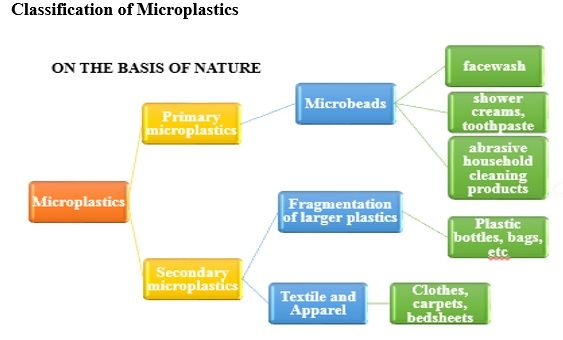
Classification on the basis of source of release
1. Microbeads in personal care products
2. Synthetic fibre garments
3. Packaging materials
4. Laundry
5. Non apparel textile sector
6. Degraded marine litter items
Some of the Microplastic Ingredients
As per a 2015 UNEP (United Nations Environment Programme) report on ‘Plastic in Cosmetics’, and a TAUW report on ‘Test to assess and prevent the emission of primary synthetic microparticles’, some of the microplastic ingredients are:
1. Polyacrylonitrile
2. Polyacrylonitrile butadiene styrene
3. Polyactide
4. Polyalkyd resins
5. Polyalkyl stereate/vinyl acetate copolymers
6. Polybuthylene/Ethylene/Styrene copolymer
7. Polybutyl acrylate
8. Polybutyl methacrylate
9. Polybutylene terephthalate
10. Polycaprolactam (Nylon 6)
11. Polycellulose acetate
12. Polyisobornyl acrylate
13. Polyisobornyl methacrylate
14. Polyisobutyl methacrylate
15. Polyisobutylene
16. Polyisoprene
17. Polylactic acid
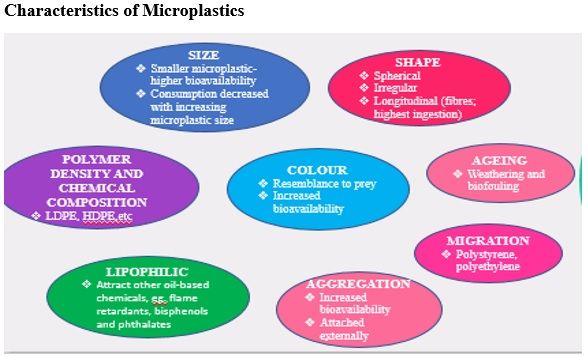
Effect of Microplastics on marine creatures
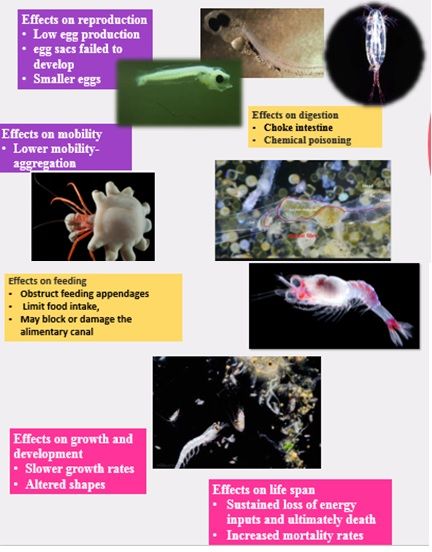
Microplastic in Humans
Microplastic transfer from prey to predator through the food chain has not been clearly demonstrated. However, a study examined participants from Finland, Italy, Japan, the Netherlands, Poland, Russia, the UK and Austria on potential effect on human health. It found that:
• Stool had microplastic particles.
• Polypropylene and polyethylene terephthalate were commonly found.
• On average, 20 particles of microplastic were found in each 10g of excreta.
• Microplastic particles could affect the digestive system’s immune response or could aid the transmission of toxic chemicals and pathogens.
• Microplastic particles can enter the bloodstream, lymphatic system and even the liver. Animal studies also show microplastics can cause intestinal damage.
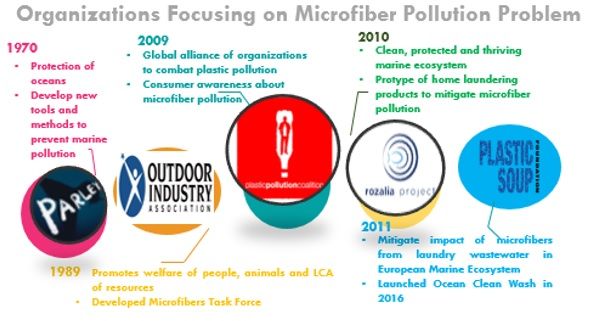
Solutions for Prevention of Microplastics
• Awareness raising about the microfibre problem
• Microfibre loss during the washing process can be decreased by washing at a low temperature, using liquid detergent instead of washing powder, using a softener and washing with a full load.
• Advocate for Wastewater Treatment Reform
• Support Regulation for Washing Machine Retrofits
• Purchase Biodegradable Materials
• Use already available solutions like Guppy Friend Washing Bag and Cora Ball
• Finishing treatments based on chitosan and pectin (Mermaid Foundation)
• Wash less often and use a front-load washing machine
• Use filter bags/fabric filters
Conclusion
The first step to solve the issue of microfibre is to raise awareness. To date, there is no international law regulating microfibre release from textile products. Microfibre pollution is raising international concern about the volumes of synthetic garments that are made by many retailers and brands. The problem of microfibre pollution has various solutions that can greatly decrease the amount of microplastics entering the environment. There is a need to raise the concern and bring laws for regulating the release of microfibres. But ultimately, everyone needs to do their part to cut back the problem of plastic pollution by following ‘Buy less and better; wash less and better’.



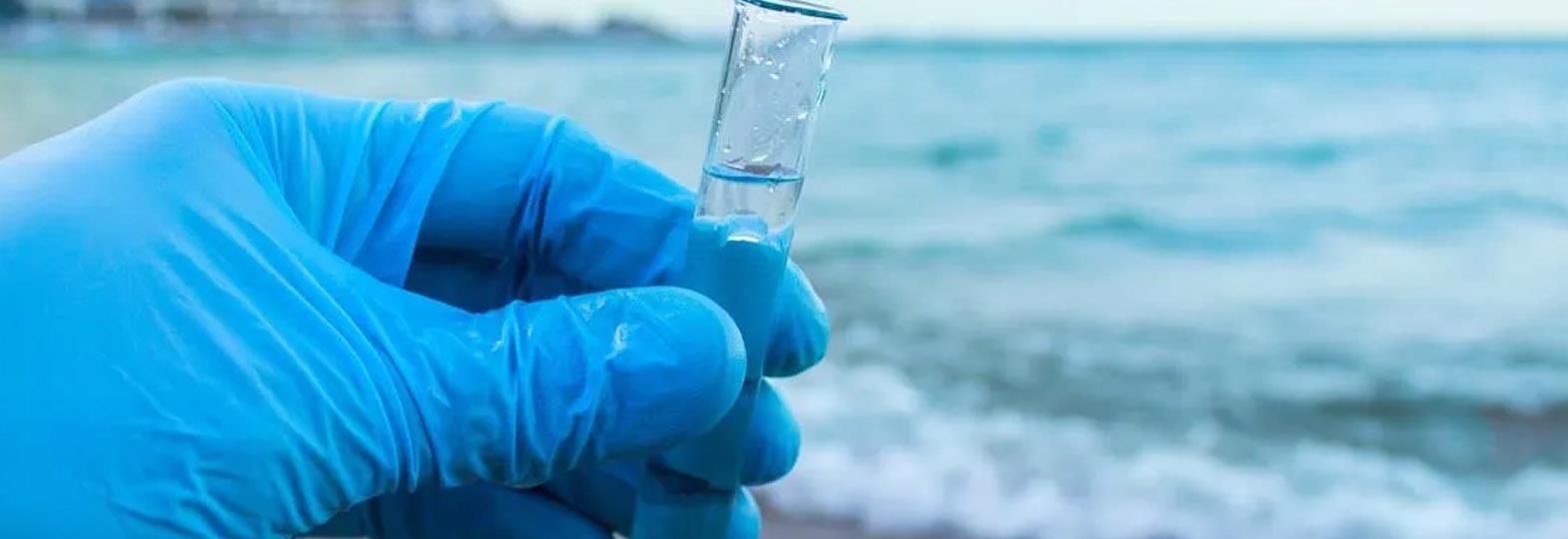




Comments